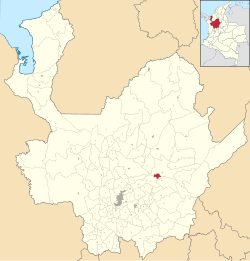This article relies largely or entirely on a single source .(September 2020) |
Cisneros, Antioquia | |
|---|---|
Municipality and town | |
 | |
 Location of the municipality and town of Cisneros, Antioquia in the Antioquia Department of Colombia | |
| Coordinates: 6°32′18″N75°05′19″W / 6.53833°N 75.08861°W | |
| Country | |
| Department | |
| Subregion | Northeastern |
| Elevation | 1,050 m (3,440 ft) |
| Population (2015) | |
• Total | 9,058 |
| Time zone | UTC-5 (Colombia Standard Time) |
Cisneros is a town and municipality in the Antioquia Department, Colombia. Part of the subregion of Northeastern Antioquia, it lies at an altitude of 1,050 m (3,440 ft) above sea level.

